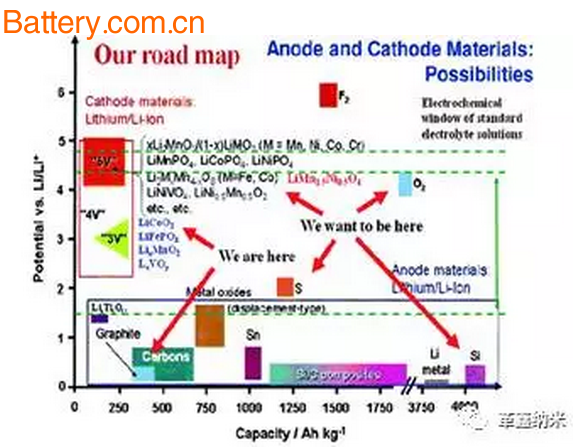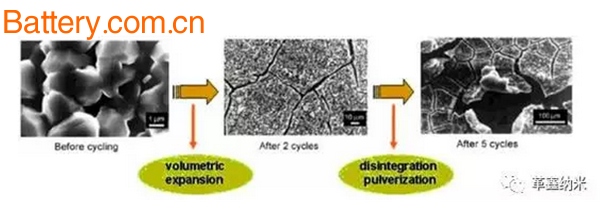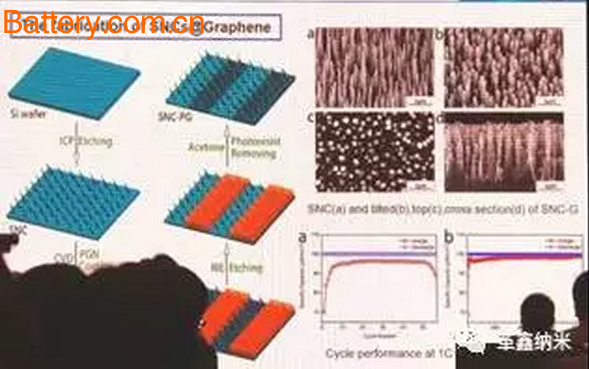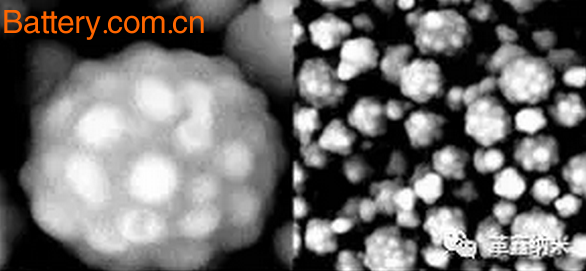After the large-screen and diversified functions of digital terminal products, new requirements are imposed on the battery life. At present, the capacity of lithium battery materials is low, which cannot meet the increasing demand of terminals for batteries. As a kind of future anode material, silicon-carbon composite material has a theoretical gram capacity of about 4200 mAh/g, which is more than 10 times higher than 372 mAh/g of graphite-based anode. After industrialization, the capacity of the battery will be greatly improved.
Several potential lithium battery materials
1. Silicon-carbon composite anode material
After the large-screen and diversified functions of digital terminal products, new requirements are imposed on the battery life. At present, the capacity of lithium battery materials is low, which cannot meet the increasing demand of terminals for batteries.
As a kind of future anode material, silicon-carbon composite material has a theoretical gram capacity of about 4200 mAh/g, which is more than 10 times higher than 372 mAh/g of graphite-based anode. After industrialization, the capacity of the battery will be greatly improved. At present, major material manufacturers are developing silicon-carbon composite materials, such as BTR, Gexin Nano, Shanshan, Huawei, Samsung and so on. The main problems with silicon-carbon composites today are:
1. When charging and discharging, the volume expands and the liquid absorption capacity is strong; 2. The cycle life is poor. At present, the above problems are solved by silicon powder nanocrystallization, silicon carbon coating and doping, and some enterprises have made certain progress.
2. Lithium titanate
In recent years, domestic research and development of lithium titanate has a high enthusiasm. The advantages of lithium titanate are as follows: 1. Long cycle life (up to 10,000 times), which is a zero-strain material (volume change is less than 1%), and does not generate tradition. The meaning of the SEI film; 2, high security. The lithium insertion potential is high, no dendrites are formed, and the thermal stability is extremely high during charging and discharging; 3. It can be quickly charged.
At present, the main factor limiting the use of lithium titanate is that the price is too high, higher than conventional graphite, and the lithium silicate has a very low gram capacity of about 170 mAh/g. Only by improving the production process and reducing the production cost, the long cycle life and fast charge of lithium titanate can play a role. In combination with the market and technology, lithium titanate is more suitable for use in buses and energy storage areas where space is not required.
3. Graphene
Graphene has received worldwide attention since it won the Nobel Prize in 2010, especially in China. There has been a boom in graphene research and development in China, which has many excellent properties, such as good light transmission, excellent electrical conductivity, high thermal conductivity and high mechanical strength. The potential applications of graphene in lithium ion batteries are as follows: 1. As a negative electrode material. Graphene has a high gram capacity and a reversible capacity of about 700 mAh/g, which is higher than the capacity of a graphite-based negative electrode. In addition, the good thermal conductivity of graphene ensures its stability in the battery system, and the graphene sheet spacing is larger than that of graphite, which makes the lithium ions diffuse smoothly between the graphene sheets, which is beneficial to improve the battery power performance. Because the production process of graphene is immature and the structure is not stable, there are still some problems in the use of graphene as a negative electrode material, such as low initial discharge efficiency, about 65%; poor cycle performance; higher price, significantly higher than traditional graphite negative electrode. . 2. As a positive and negative electrode additive, it can improve the stability of lithium battery, prolong cycle life and increase internal conductivity.
In view of the current immature mass production process of graphene, high price and unstable performance, graphene will be the first to be used as a positive and negative electrode additive in lithium ion batteries.
4. Lithium-rich manganese-based cathode material
High capacity is one of the development directions of lithium batteries, but the current density of lithium iron phosphate in the positive electrode material is 580Wh/kg, and the energy density of lithium nickel cobalt manganese oxide is 750Wh/kg, which is low. The theoretical energy density of lithium-rich manganese base can reach 900Wh/kg, which has become a research and development hotspot.
The advantages of lithium-rich manganese as a positive electrode material are as follows: 1. High energy density; 2. The main raw materials are abundant. Due to the short development time, there are a series of problems in the current lithium-rich manganese base: 1. The first discharge efficiency is very low; 2. The material is oxygenated during the cycle, which brings safety hazards; 3. The cycle life is very poor; 4. The rate performance is biased. low.
At present, the means for solving these problems are coating, acid treatment, doping, pre-circulation, heat treatment and the like. Although the lithium-rich manganese base has obvious advantages in capacity and huge potential, it is limited to slow progress in technology, and it takes time to market in large quantities.
5, power type nickel cobalt manganese oxide material
The route of the power battery has been controversial for a long time, so lithium iron phosphate, lithium manganate, and ternary materials have been adopted. The domestic power battery route is mainly based on lithium iron phosphate, but with the popularity of Tesla , the ternary material route used by it has caused a boom.
Although lithium iron phosphate has high safety, its energy density is low and the soft ribs cannot be overcome. New energy vehicles require longer cruising range. Therefore, in the long run, materials with higher capacity will replace lithium iron phosphate as the next generation mainstream technology. route.
Nickel-cobalt-manganese ternary materials are most likely to become the mainstream material for the next generation of power batteries in China. Domestically introduced electric vehicles with ternary routes, such as Beiqi E150EV, Jianghuai IEV4, Chery EQ, and Azure, the unit weight density is greatly improved compared with lithium iron phosphate batteries.
6, carbon nanotubes
Carbon nanotubes are not new, and they have been extensively studied as hydrogen storage materials, but their use in lithium batteries is relatively late. Carbon nanotubes were sold in 2009, and because of the high price, almost no one cares. Nowadays, with the improvement of process, the cost reduction, and the higher requirements of the internal system of lithium battery, carbon nanotubes are gradually recognized by battery companies.
Nowadays, the capacity and power of lithium batteries are getting higher and higher, and the excellent performance of carbon nanotubes comes in handy. The advantages of carbon nanotubes as conductive agents for lithium batteries are as follows: 1. Excellent electrical conductivity, electrical resistivity of 2-6*10-4 Ω·cm; 2. Excellent thermal conductivity, thermal conductivity of carbon nanotubes at room temperature can reach 6000w /m/k, can effectively transfer the heat accumulated during battery charging and discharging, especially in the case of high magnification, with the rise of high capacity and high rate cells, carbon nanotubes will be widely used.
7, coated diaphragm
Diaphragms are critical to the safety of lithium batteries, which require good electrochemical and thermal stability of the separator and high wettability of the electrolyte during repeated charge and discharge.
Coating a separator means coating an adhesive such as PVDF or ceramic alumina on the base film. The function of coating the membrane is: 1. Improve the heat shrinkage of the membrane, prevent the membrane from shrinking and cause a large area short circuit; 2. The coating material has low thermal conductivity, and prevents some thermal runaway points in the battery from expanding to form an overall thermal runaway.
8, ceramic alumina
In the coated diaphragm, the ceramic coated diaphragm is mainly for the power battery system, so its market growth space is larger than that of the rubberized diaphragm, and the market demand for the core material ceramic alumina will be greatly improved with the rise of the ternary power battery.
The purity, particle size and morphology of the ceramic alumina used for coating the separator are very high. The products in Japan and South Korea are more mature, but the price is more than double that of the domestic one. At present, there are many companies in China that are developing ceramic alumina, hoping to reduce import dependence.
9, high voltage electrolyte
Increasing the battery energy density is one of the trends of lithium batteries . At present, there are two main methods for increasing the energy density: one is to increase the charge cut-off voltage of the conventional positive electrode material, such as raising the charging voltage of lithium cobaltate to 4.35V and 4.4V. However, the method of increasing the charge cut-off voltage is limited. Further increasing the voltage will cause the lithium cobaltate structure to collapse and the properties are unstable. Another method is to develop a new positive electrode material with a higher charge and discharge platform, such as lithium-rich manganese. Lithium nickel cobaltate, etc.
After the voltage of the positive electrode material is increased, a high-voltage electrolyte is required, and the additive plays a key role in the high-voltage performance of the electrolyte, which has become a research and development focus in recent years.
10, water-based binder
At present, the positive electrode material mainly uses PVDF as a binder and is dissolved by an organic solvent. The binder system of the negative electrode includes SBR, CMC, a fluorine-containing olefin polymer, and the like, and an organic solvent is also used. In the process of making the electrode sheet, the organic solvent needs to be dried and volatilized, which pollutes the environment and endangers the health of the employee. The dried solvent was evaporated require special freezing equipment collected and processed, and the fluorine-containing polymer and solvent is expensive, the production cost increase of the lithium battery. In addition, the SBR/CMC binder is easy to stick to the roll during processing, and is difficult to use for the preparation of the positive electrode sheet, and the use range is limited.
The development of water-based adhesives is imperative due to environmental considerations, cost reduction, and increased performance of polar sheets.
Silicon carbon material is the most promising lithium battery anode material

Silicon is the most negative anode material for lithium-ion batteries discovered by humans so far (4200mAh/g). It is one of the most promising anode materials. However, silicon has some bottlenecks as a negative electrode for lithium batteries. The first problem is silicon. There is a problem of volume expansion in the reaction. Through theoretical calculations and experiments, it can be proved that both lithium intercalation and delithiation cause volume changes, and this volume change is 320%. So no matter what kind of material is made, microscopically, at the atomic or nanoscale of silicon, its expansion is 300%. Large volume changes must be considered when designing materials. High volumetric materials can cause mechanical problems locally, and a series of basic studies have shown that it cracks and forms severe shedding.
The volume expansion of silicon leads to a series of results:
1. Particle pulverization, poor cycle performance

2. Poor contact between active material and conductive agent binder

The second problem is that the SEI film on the silicon surface is relatively thick and uneven, and is greatly affected by temperature and additives, which affects the overall specific energy in the lithium ion battery.

The graphite surface is particularly good in electrical conductivity, and the SEI film is relatively uniform, and its composition is different from that of the silicon negative electrode. In order to study this problem, relevant scientists from the Chinese Academy of Sciences have made model materials and made silicon nano-pillars by micro-machining. Observing the growth of SEI film during charging and discharging, we found that as the number of cycles increases, the SEI film gradually fills the gap in the middle of the silicon column, and will continue to grow about 4.5 μm after covering. Without any treatment, the SEI film can grow very thick. This means that it is porous and the solvent is always exposed to the surface of the silicon so that it is not possible in a full battery design. How to solve this problem, the Chinese Academy of Sciences related scientists made some attempts to do carbon coating on silicon, in order to make a comparison, we only made part of the graphene coating on the silicon, and other places are vacant. Finally, it is seen that the growth of the coated and uncoated SEI film is different, the carbon-coated SEI film is significantly reduced, and there are many uncoated SEI films.

From the long-term basic research, 1 through silicon powder nanocrystallization; 2 silicon carbon coating; and other technical means can effectively solve the problems encountered in the negative application of silicon in lithium batteries. Whether it is nano-silicon carbon or SiO2 carbon, silicon strives to achieve the following:
Silicon particle size: <20nm (the smaller the theoretical is better); uniformity: standard deviation less than 5nm; purity: >99.95%; morphology: 100% sphericity.

In addition, a complete surface coating is important to prevent silicon from contacting the electrolyte, resulting in a thick SEI film. The design of the microstructure is also important to maintain the contact of electrons during the cycle, the passage of ions, and the expansion of volume.

The carbon coating mechanism is that the volume expansion of Si is shared by the graphite and the amorphous coating layer, and the anode material is prevented from being pulverized due to huge volume change and stress during the intercalation and deintercalation process. The role of carbon coating is:
(1) Constraining and buffering the volume expansion of the active center
(2) Preventing the agglomeration of nano-active particles
(3) Prevent the electrolyte from penetrating into the center, maintaining a stable interface and SEI
(4) Silicon material contributes high specific capacity, and carbon material contributes high conductivity
Silicon carbon negative electrode has a very broad market space
The anode material technology is relatively mature, and its concentration is relatively high, and the production capacity is obviously shifted from Japan to China. At present, the anode material is mainly composed of carbon materials, which accounts for the low cost of lithium batteries, and is basically industrialized in China. From a regional perspective, China and Japan are the world's major producers and sellers, and the negative electrode purchases of power battery companies are mainly from Japanese companies.
China's anode material production in 2012-2016 (10,000 tons)
In 2015, the global shipment of negative electrode materials was 110,800 tons, a year-on-year increase of 29.59%. Among them, the shipment of China's anode materials reached 72,800 tons, an increase of 41.1% year-on-year, accounting for 66%. In recent years, with the continuous improvement of China's production technology, China is also a major producer of anode materials, and the lithium battery anode industry has continued to shift to China, and the market share has been continuously improved. The silicon carbon anode material is the most potential application of lithium battery anode materials in the future. It can be seen that the market capacity of silicon carbon anode materials is large, which explains why many companies and research units have laid silicon carbon anode materials.
Kage's Car hose have many series for stainless Steel Braided Hose and Nylon Cover braided PTFE hose and PTFE HOSE WITH BLACK PVC COAT and more type. We supply the best quality Braided Hose available on the market! It is strong, hard wearing and the close weave will not allow the hose through the braid. Quality finished for your Street Machine, Hot Rod, Customization, Bike, Boat or daily driving cars. This an economical way to dress up your engine bay.
Silicone Car Hose,Radiator Hose,Heater Hose,Coolant Hose
Kage Hardware Product Co., Ltd , http://www.kage-autofittings.com